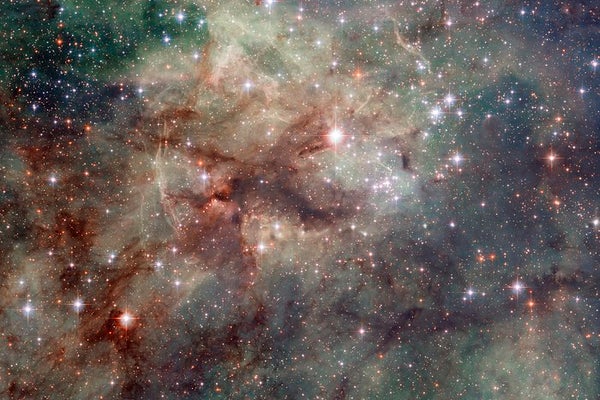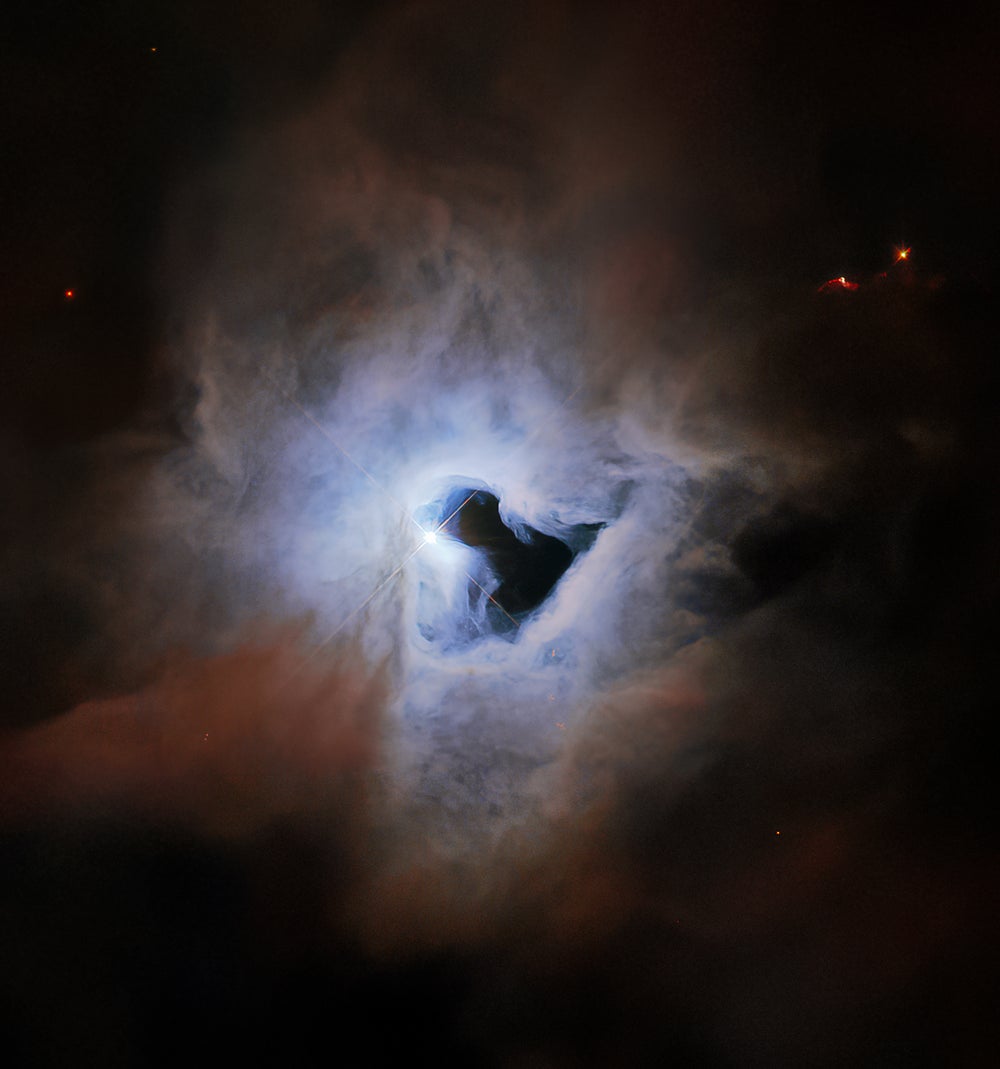Celebrate Hubble Space Telescope’s 35th Birthday with Stunning Images
Happy anniversary to the Hubble Space Telescope, which launched on April 24, 1990

The Tarantula Nebula, located about 161,000 light-years away in the Large Magellanic Cloud bordering our Milky Way, is packed with ionized hydrogen gas dotted by supernova remnants.
Thirty-five years ago today a revolutionary new era of astronomy began when the Hubble Space Telescope, tucked onboard the space shuttle Discovery, blasted off Earth into history. The next day a robotic arm tipped the telescope into orbit from the shuttle’s cargo bay. Within a month Hubble had truly begun its mission, gazing out at the cosmos for NASA and the European Space Agency with its 2.4-meter-wide starlight-gathering mirror—the largest ever launched to space at the time.

NGC 6302, known as the Butterfly Nebula, is located between 2,500 and 3,800 light-years away in the constellation Scorpius. The image includes near-ultraviolet, visible and near-infrared light. At the heart of the nebula lie one or more dying stars that are periodically flinging layers of gas out into space. This gas—reaching temperatures of more than 36,000 degrees Fahrenheit and speeds of more than 600,000 miles per hour—becomes the “wings” of the butterfly.
In the years since, Hubble has gathered more than 1.6 million observations and 430 terabytes of data. The telescope has revealed that supermassive black holes nestle at the heart of most large galaxies, Jupiter’s icy moon Europa may be shooting plumes of water out into space and, in the distant future, our Milky Way galaxy will likely collide with our neighbor, Andromeda.
On supporting science journalism
If you’re enjoying this article, consider supporting our award-winning journalism by subscribing. By purchasing a subscription you are helping to ensure the future of impactful stories about the discoveries and ideas shaping our world today.
But the mission almost flopped.
The Hubble Space Telescope was decades in the works, even making a cameo appearance in a Superman comic in 1972, before it reached space in 1990. But after Hubble’s deployment, as the telescope began operations, astronomers realized its vision was blurry and traced the issue to a tiny imperfection in the telescope’s mirror.

A pair of planetary nebulae, IC 418 (left) and MyCn18 (right). IC 418 is located about 2,000 light-years away from Earth in the direction of the constellation Lepus. At its heart is the remains of a red giant star that spat its outer layers of gas into space, creating the lattice of gas illuminated by ultraviolet light. MyCn18, located about 8,000 light-years away, glows with ionized nitrogen (red), hydrogen (green) and doubly ionized oxygen (blue).
NASA and The Hubble Heritage Team (STScI/AURA); Acknowledgment: Dr. Raghvendra Sahai (JPL) and Dr. Arsen R. Hajian (USNO) (CC BY 4.0) (left); NASA, ESA, Raghvendra Sahai and John Trauger (JPL), the WFPC2 science team (CC BY 4.0) (right)
Astoundingly, that mirror is still in use today aboard the observatory. Fortunately, Hubble was uniquely designed to be serviced in orbit by astronauts. NASA’s first (and most urgent) servicing mission flew in December 1993; during five separate spacewalks, astronauts installed a new primary camera able to counteract Hubble’s blurred vision, as well a bulky new apparatus that corrected the light that fed into the observatory’s original suite of instruments.

The Hubble Space Telescope and a spacewalking NASA astronaut are seen in orbit around Earth during STS-61, the 1993 servicing mission to correct the observatory’s optics.

M104, nicknamed the Sombrero Galaxy, is located about 30 million light-years away in the constellation Virgo. M104 creates stars surprisingly slowly and is home to a mysteriously quiescent central supermassive black hole.
Additional shuttle missions in 1997, 1999, 2002 and 2009 also visited the observatory, extending its lifetime and expanding its view each time with new hardware and better instruments.

The galaxy NGC 1566 is located about 60 million light-years from Earth in the constellation Dorado. NGC 1566 is what scientists call a weakly barred or intermediate spiral galaxy and belongs to a group of gravitationally bound galaxies that astronomers are still working to understand.
ESA/Hubble & NASA, D. Calzetti and the LEGUS team, R. Chandar (CC BY 4.0)
The results have been nothing short of breathtaking. Hubble’s position well above most of Earth’s atmosphere allows it to see the cosmos unhindered by the tempests and turbulence that all ground-based observatories face. That privileged vantage point has profoundly shaped our understanding of the solar system and universe around us.
In our own neighborhood, Hubble has studied the changing weather on the outer planets, discovered moons orbiting Pluto and watched the once-in-a-lifetime impact of Comet Shoemaker-Levy 9 on Jupiter scar the giant planet with dark spots as big as Earth. It has even glimpsed the sun, in a feat it was most definitely not designed to attempt.

Hubble used its ultraviolet vision to capture an image of auroras on Jupiter in 2016 as NASA’s Juno spacecraft was arriving in orbit around the massive planet.
NASA, ESA, and J. Nichols (University of Leicester); Acknowledgment: A. Simon (NASA/GSFC) and the OPAL team (CC BY 4.0)
In more distant reaches, Hubble provided conclusive proof that supermassive black holes exist and made the first observations of astronomical objects colliding as well as of the surface of a star besides our sun. And in a remarkable triumph, it managed to capture a first-of-its-kind snapshot of a supernova explosion that had been successfully predicted by astronomers.

The dense globular cluster ESO 520-21, or Palomar 6 (top), is located near the center of the Milky Way in the constellation Ophiuchus. The Carina Nebula (bottom) is a star-forming region located about 7,500 light-years away from Earth in the constellation Carina. The pillar of dust and gas seen in this image stretches about three light-years tall and is being eroded away by radiation from hot newborn stars embedded in the column.
ESA/Hubble and NASA, R. Cohen (CC BY 4.0) (top); NASA, ESA, M. Livio and the Hubble 20th Anniversary Team (STScI) (CC BY 4.0) (bottom)
And, of course, it has taken some of the most iconic space photographs we have—among them, the stunning “Pillars of Creation” image of a stellar nursery known as the Eagle Nebula.
For 35 years Hubble has pushed the boundaries of possibility, transforming our view of the cosmos each time it beams the universe’s light down to Earth. How long it will continue to do so, however, remains unclear. Since the 2009 servicing mission, the NASA shuttles that ferried astronauts to Hubble retired, and the hazards of space have taken their toll. Hubble’s hardware failures are mounting, and the observatory’s ongoing operations depend on an ever-increasing number of workarounds and improvisations. At this point, even the most optimistic “Hubble hugger” astronomers admit that the observatory’s days are numbered.

Although Hubble is most known for its iconic photographs, it gathers other observations as well, such as this single exposure taken by the observatory’s Space Telescope Imaging Spectrograph. The image maps gas zipping around the supermassive black hole at the center of the galaxy M84, located about 50 million light-years away from Earth. From the spectrograph’s data, which show that the gas is moving as fast as 880,000 miles per hour, astronomers determined that the black hole contains at least 300 million times the mass of our sun.
NASA, Gary Bower, Richard Green (NOAO), the STIS Instrument Definition Team
In June 2024 NASA announced that failing machinery was forcing the observatory to begin operating with only one fully functional gyroscope, which slows the telescope’s work. In addition, Earth’s atmosphere is slowly but surely pulling Hubble down to Earth, bringing the observatory ever closer to fiery destruction, although reentry is not expected until next decade.
NASA launched Hubble’s successor, the James Webb Space Telescope, in 2021, although unlike Hubble, JWST is stationed so far beyond Earth’s orbit that crewed servicing missions are too daunting to attempt. The two telescopes mostly collect data independently of each other but occasionally team up, combining their powers to produce spectacular results.

NGC 1999, located about 1,350 light-years away from Earth, is a reflection nebula created by debris from the newborn star V380 Orionis, visible at the center of the image. The image relies on data gathered by Hubble’s Wide Field Planetary Camera 2—the replacement camera installed during the first servicing mission—in 1999.
Despite its age, Hubble may yet be reborn. In 2022 billionaire Jared Isaacman, who has paid SpaceX undisclosed sums for several private spaceflights with the company, proposed a new servicing mission for the aging telescope. NASA officials seriously considered the proposal but in 2024 declined to pursue Isaacman’s idea.

The lenticular galaxy NGC 4753 is located about 60 million light-years away from Earth in the constellation Virgo. Lenticular galaxies are elliptical objects; Hubble sees this particular galaxy nearly edge on. Scientists believe that the galaxy developed after a merger some 1.3 billion years ago.
Now Isaacman is President Donald Trump’s nominee to lead NASA. Senators conducted his confirmation hearing earlier this month; a vote has not yet been scheduled. It’s not clear how ethics rules will impact Isaacman’s relationship with SpaceX should he be confirmed or whether he would have the authority to resurrect the servicing mission proposal.

NGC 7635, nicknamed the Bubble Nebula, is located about 7,100 light-years away from Earth in the constellation Cassiopeia. The nebula is about seven light-years wide; at its heart is a star 45 times as massive as our sun that is spitting gas into space at speeds as high as four million miles per hour.
NASA, ESA, and the Hubble Heritage Team (STScI/AURA) (CC BY 4.0)
And larger issues face the agency than the fate of any single observatory. Hubble and JWST are the only astrophysics telescopes that would continue to receive funding amid massive science cuts included in the Trump administration’s budget request for NASA. (That said, budget allocations are made not by the president but by Congress, which has a long history of reinstating money to slashed space science projects.)
Such is the limitation of an astronomical marvel: while Hubble has spotted a star as it was less than one billion years after the big bang, even it cannot see its own future.

